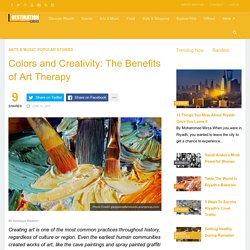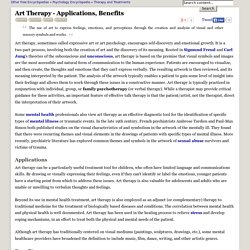

Art therapy enhance the ability to engage imagination and optimise health and wellbeing. Art Therapy Helps Mental Patients Unmask Conflicts. The Benefits of Art Therapy in the Immigration Field. Summary Presentation given at the 3 rd European Conference on Psychotherapy, AEP (Association of European Psychiatrists), Heidelberg , Germany , 2003.

This paper deals with the author's observations applying art therapy in the centre SAPPIR, Barcelona , and the advantages of this discipline in the immigartion field: Art therapy reduces importance of verbalization, so the patient does not have to know well the therapist's or host country's language/s. The patient can use his/her symbolization and choose his/her rhythm without having to adapt it to the therapist's or the host country's culture. The artistic creation provides a safe focus to explore the positive and negative aspects of one's own or the host country's culture.
The artistic creation can support one's cultural identity especially in situations of conflict between the original and host country's culture. Resumen: Colors and Creativity: The Benefits of Art Therapy. Photo Credit: peoplemattersleeds.wordpress.com By Sumaiyya Naseem Creating art is one of the most common practices throughout history, regardless of culture or region.

Even the earliest human communities created works of art, like the cave paintings and spray painted graffiti of Indonesia. A big misconception at the centre of this activity is that only natural talent can result in a work of art. That, of course, is not true. Here’s a truth for you: art is not just about expressing creatively, it is also a form of therapy. Therapeutic Use of Expressive Arts With Children. Therapeutic Use of Expressive Arts With Children By Don Phelps, PhD, LCSW In broken English, a 13-year-old boy asked if he could draw me a picture.

I sat with him as he sketched a superhero he had seen on TV. The boy was very talented and drew with great detail and passion. When he finished, he smiled, gave the picture to me, and proudly said, “For you. Welcome!” It was my first day volunteering at Casa Hogar Los Angelitos (CHLA) in Manzanillo, Mexico. During my professional career as a social worker, I have been privileged to visit many orphanages around the world. A Success Story I started my sabbatical experience at CHLA with the following questions: Why is CHLA so effective with difficult-to-place children given its limited resources? I discovered many reasons for CHLA’s success while I was there. Children receive music instruction and have regular access to instruments. Expressive arts are integrated into each stage of the children’s development. References Aron-Rubin, J. (2005). How can Art Therapy benefit people with depression, anxiety, stress.
While sometimes people can speak about their thoughts and feelings very well, this is not always easy for lots of reasons: particularly if they are experiencing depressive symptoms such as low mood, self esteem and confidence.

A person may be feeling isolated and not feel much like talking to other people about they feel. People sometimes describe that when they are depressed they feel like they are in a dark tunnel which appears difficult to escape from. When feeling like this it can be challenging to find a way to communicate with others, it may be that there are no words to accurately describe how you are.
Other people can find that no matter how much they talk about their feelings it does not appear to help and they need other ways to help express them more fully. They may be emotionally disconnected from what they are saying and need a bridge to help them to reconnect. The Healing Benefits of Art Therapy. Art Therapy - Applications, Benefits - Mental, Feelings, Visual, and Artwork - JRank Articles.
The use of art to express feelings, emotions, and perceptions through the creation and analysis of visual and other sensory symbols and works.

Art therapy, sometimes called expressive art or art psychology, encourages self-discovery and emotional growth. It is a two-part process, involving both the creation of art and the discovery of its meaning. Rooted in Sigmund Freud and Carl Jung's theories of the subconscious and unconscious, art therapy is based on the premise that visual symbols and images are the most accessible and natural form of communication to the human experience. Patients are encouraged to visualize, and then create, the thoughts and emotions that they can't express verbally. The resulting artwork is then reviewed, and its meaning interpreted by the patient. Some mental health professionals also view art therapy as an effective diagnostic tool for the identification of specific types of mental illness or traumatic events.
Applications Benefits Self-discovery.